In the meantime, the barn has been completed, including the doors. We would like to take this opportunity to thank Hallenbau Schmeing for donating the door rails and all the other donors who made the construction possible. The barn is a great help and protects not only from theft but also from the merciless sun during many jobs.
We are currently still lacking some money to purchase a no-till drill.

The conditions for arable farming in Central Europe and the tropics differ greatly. There is the year-round strong solar radiation, which leads to high soil temperatures. The minimum temperature here in Togo is 28°C and the well water from a depth of 30 m is 27°C! If this warm soil is aerated by cultivation, a rapid transformation of the existing humus is inevitable and CO2 remains! Read more here .
At midday, the temperature of the uncovered soil rises to 40°C and the available soil water will evaporate quickly! Effective water storage as well as nutrient storage is only possible with sufficient humus!

Further very interesting information on the subject of humus depletion in the tropics
in german: derpsch-en-pdf
in english: derpsch-engl-pdf

The tropical climate poses further problems: very heavy rainfall, sometimes 100 mm or more per day, easily washes out dissolved fertilizer salts such as those in mineral fertilizers into deeper soil layers, and it is also important to store as much of the rainwater as possible. A sufficient humus layer can take over both tasks. I have set up a small weather station for more precise rainfall recording.
Very bad for the humus balance is the still practiced slash-and-burn, a tradition that still comes from the fact that the tribes moved around and burned areas to use them for 3-4 years. After that, the soil was exhausted and the tribes moved on.
Here in Togo, the months of December, January and February are the dry season and the undergrowth dries out. Fires are then often set to prepare the land or to drive out the last of the game. There is no fire department here and so the fires, which are officially forbidden, sometimes get out of control.


Here in the photo we can see how corn is traditionally sown: 3 grains together, usually on a ridge, and then a lot of space, 75cm to 1m, in between. I don't know where this tradition comes from, but I usually hear the explanation: if one grain fails, the other grains will grow. A former apprentice of mine works on a large farm in the south of the Democratic Republic of Congo, which is about 2500 km away from Togo. And according to him, the same tradition prevails there. This method of sowing has several disadvantages: On the one hand, the maize cannot develop optimally as a result of the competitive situation, and on the other hand, the poor stand space distribution leaves a lot of room for weeds and the already scarce nutrients are also consumed by the weeds. Ridge cultivation also promotes water scarcity because the rainwater runs off the ridge and the strong soil aeration promotes rapid humus decomposition!

What would be the solution to all these difficulties? It is direct sowing, which has been successfully practiced in Brazil for over 50 years. There, 2 harvests per year are the standard and also possible for Togo in the same climate. You can find extensive information here in DE, En, Esp
But simply switching to no-till and not burning the cut undergrowth increases yields by 50%. This is also due to the fact that the soil covered with residual plants evaporates around 45% less water. My wife Anita and I learned all this during a visit to the Centre for No Till training farm in Ghana in April 24, you can find out more about the farm here
The leader, Dr. Kofi Boa, had to watch as a 12-year-old how his mother's cocoa plantation was destroyed by fire because a neighbor thought he had to burn something and the fire got out of control. He vowed to do something about these unfortunate fires, studied agriculture and later received support from the Howard G. Buffet Organization Link here
On the farm in Ghana, we were able to see various types of beans and other legumes in the trial field. Legumes are able to utilize atmospheric nitrogen (78% N is in the air we breathe) and also store it in the soil, and nitrogen (N) is one of the most important plant nutrients.
There are various ways of using legumes, either as a catch crop to enrich the soil with N or the beans are sown between the maize rows approx. 10 days after maize sowing, thus supplying the maize with nitrogen. The soybean is also a legume and is often grown in Brazil as the first crop before maize.
In the photo you can see seeds of various legumes and other plants that are being grown and tested in Ghana. Other plants are constantly being tested, including some that make soil phosphate, another important nutrient alongside potassium, available to plants.



My idea is to lease 1-2 hectares of land and show the Togolese how to grow crops using direct sowing. I know from my own experience that it is difficult to dissuade farmers in particular from their traditions, but if I can show the Togolese farmers ways for a better life without all this hardship and out of poverty, then I think the project would be convincing!
Then the farmers would not have to sell their harvest directly due to lack of money, but would have to store at least part of it. When you consider that around 70% of the population currently work in agriculture, it becomes clear what opportunities for improving living conditions are hidden here.
To realize this project, we still need a direct seeding machine similar to the one we have seen in Ghana.
Unfortunately, there is still a lack of donations for the purchase of such a machine and I would be very happy if people in Germany could be found to support the project with a donation and thus successfully help the Togolese people.
And that's the only reason I'm in Togo: to help the people!

The construction of the barn can finally continue. We had to stop building for 8 months because there were disagreements about the ownership of the land. This is a big problem here in Togo because there is not yet a complete land register like in Germany. But we were able to clear up all the uncertainties and so we can continue quickly.

The carpenters work with very few tools: a foxtail, hammer, string, tape measure and lots of nails. It was interesting for me to see the simple means the craftsmen use to build a roof truss with a span of 8 meters. Note the mobile scaffolding tower with wooden supports. A building permit is not required!

The roof is covered and there are even light panels. The large openings in the wall are used for air circulation and are fitted with round bars to protect against thieves. The bricklayers are very good at plastering when you consider that only cement is available! The small holes in the wall are not caused by shelling but by the clamps for the concrete formwork.

On May 15, 2024, I was finally able to pick up the tractor in Lomé. But it was worth the wait. A big thank you goes to Ludger Gausling from Heek, who donated the tractor almost single-handedly.

I have never seen a tractor with a front loader in Togo and the seller was not familiar with such a thing either. This shows the great need to catch up on technology.
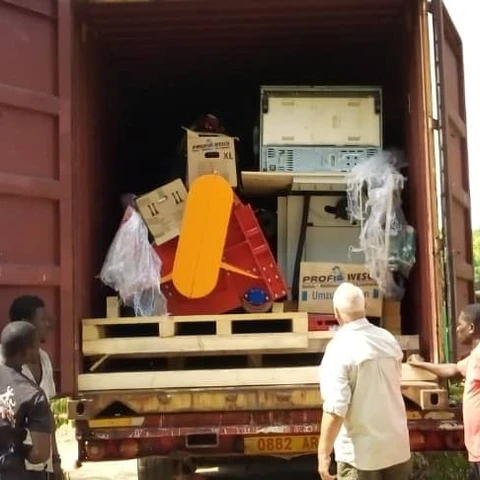 Arrival of the 2nd container in 2023. Everything arrived safely. This time I was able to organize a forklift for unloading.
Arrival of the 2nd container in 2023. Everything arrived safely. This time I was able to organize a forklift for unloading.
 The only one in Kpalimé with around 70,000 inhabitants. Here, everything is unloaded and loaded by hand. But with these machines there are limits.
The only one in Kpalimé with around 70,000 inhabitants. Here, everything is unloaded and loaded by hand. But with these machines there are limits.
 The pallet with the bikes was also well packed and the bikes were eagerly awaited.
The pallet with the bikes was also well packed and the bikes were eagerly awaited.
 As with the first container, our association received great support from the Robers Paletten company for the second. Without this help, the campaign would not have been possible. Special thanks to Andre Tenk, who stowed the flail mower here.
As with the first container, our association received great support from the Robers Paletten company for the second. Without this help, the campaign would not have been possible. Special thanks to Andre Tenk, who stowed the flail mower here.
 Mr. Wild (left) and his assistant (forwarding agent and customs clearance) and the driver (center) were amazed at the speedy loading. For Wolfgang Schulte and Andre Tenk (right), fast and precise work is both a daily routine and a recipe for success.
Mr. Wild (left) and his assistant (forwarding agent and customs clearance) and the driver (center) were amazed at the speedy loading. For Wolfgang Schulte and Andre Tenk (right), fast and precise work is both a daily routine and a recipe for success.

A big thank you to the Dücker company for donating a flail mower for use in Togo! This machine is the ideal complement to the implementation of no-till farming. If you are interested in no-till farming under tropical conditions, you will find a lot of information at: WWW.Rolf-Derpsch.com In Brazil, approx. 95% of the arable land is no-till!
On the picture from left: Werner Schmeing, 2nd chairman of our association, Anita Komedza, Hermann Schulze Herking, 1st chairman, Gerhard Dücker, Christian Dücker
Here, a pallet is being professionally loaded and secured by Josef Tenk. Many thanks to Josef for his great support!
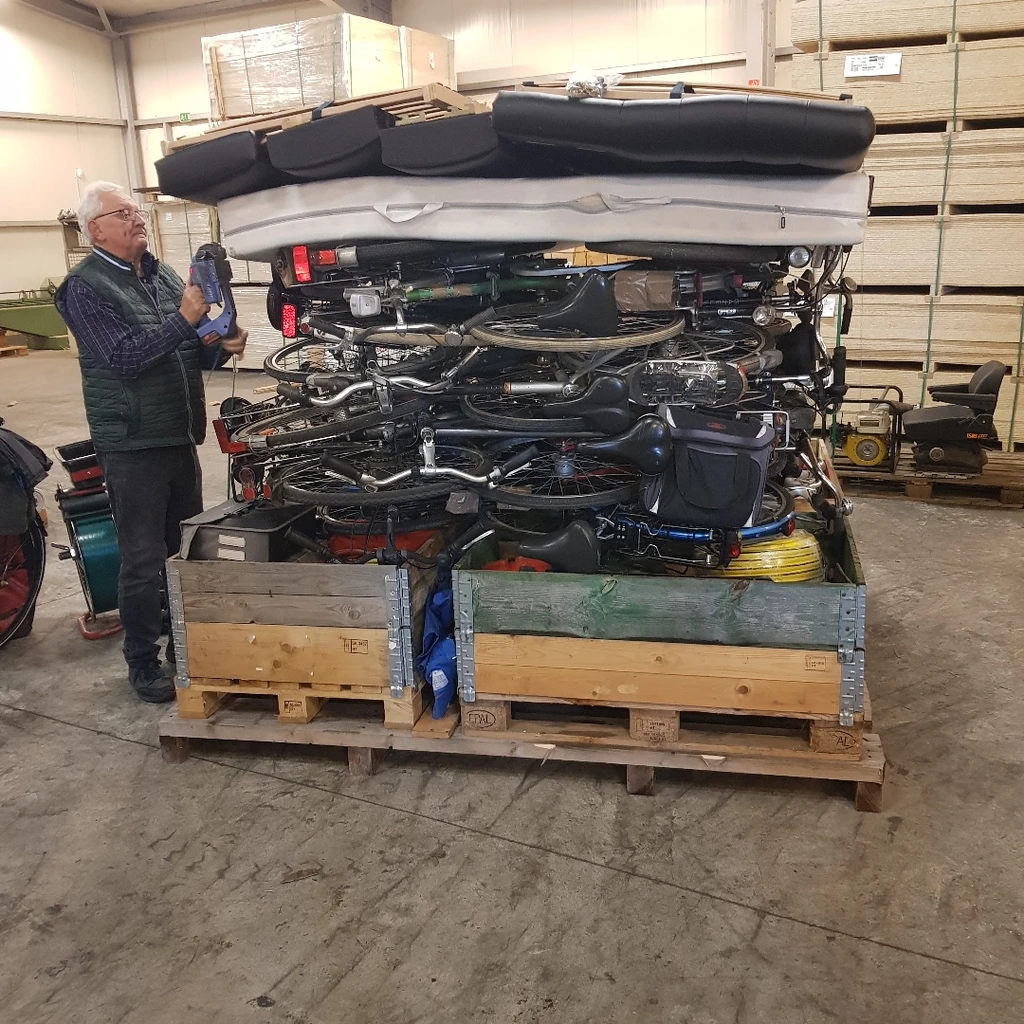
Many thanks to all the donors, a lot of things have come together. I hope we get everything into the container! Cash donations are still welcome and are still needed. But it's not long now until the project here in Togo can start.
A no-till machine for corn and soybeans is to be purchased that is not available in Germany. Most probably from Brazil. Hermann Schulze Herking has been in Südlohn since October 20. Departure is on 15.11.23 in the evening
 The container finally arrived on October 14. It had to be unloaded immediately and we had organized 17 helpers for this. Everything had to be unloaded by hand, even these heavy boxes weighing around 300 kg!
The container finally arrived on October 14. It had to be unloaded immediately and we had organized 17 helpers for this. Everything had to be unloaded by hand, even these heavy boxes weighing around 300 kg!  The biggest challenge was unloading the tipper. Piece by piece it went out. It was pushed at the top and pulled at the bottom.
The biggest challenge was unloading the tipper. Piece by piece it went out. It was pushed at the top and pulled at the bottom.
 The tipper then landed on the ground almost undamaged. The whole operation lasted from 19:00 to 00:30. The things are currently in temporary storage at Father Marian's, about 5 km away. We still have to finish the barn first.
The tipper then landed on the ground almost undamaged. The whole operation lasted from 19:00 to 00:30. The things are currently in temporary storage at Father Marian's, about 5 km away. We still have to finish the barn first.  Thanks to the donations we received, we were able to start building the barn. The association would like to take this opportunity to thank all donors.
Thanks to the donations we received, we were able to start building the barn. The association would like to take this opportunity to thank all donors.  Everything is done by hand. Even the soil is compacted by throwing the approx. 30 kg stones onto the ground again and again. An enormous effort!
Everything is done by hand. Even the soil is compacted by throwing the approx. 30 kg stones onto the ground again and again. An enormous effort! 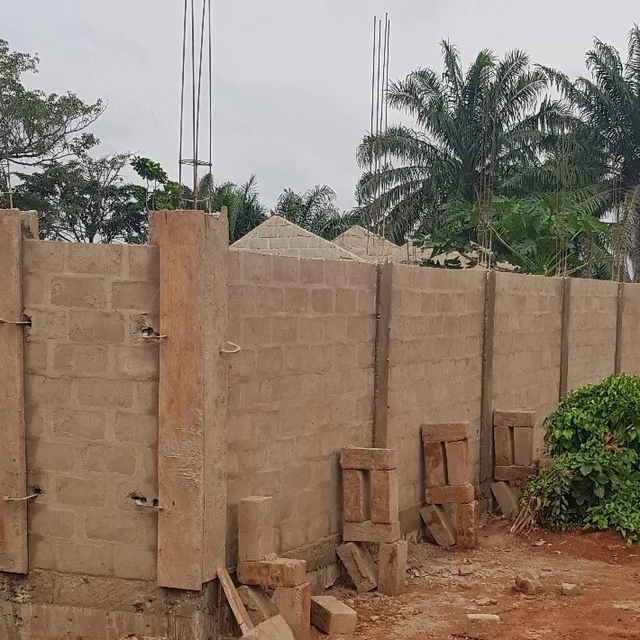 The stones leaning against the wall served as a scaffolding base.
The stones leaning against the wall served as a scaffolding base.  On August 1 at 8:45 a.m., the container loading began, stowage as the experts say. We received great support from the company Gebr. Robers in Südlohn. Boxes are loaded here that fit exactly into the container. Many thanks for the donation of the crates by Gebr.
On August 1 at 8:45 a.m., the container loading began, stowage as the experts say. We received great support from the company Gebr. Robers in Südlohn. Boxes are loaded here that fit exactly into the container. Many thanks for the donation of the crates by Gebr.
 The most difficult part is loaded here. A 5 m long pallet with the trailer on top. Every space on and under the trailer was used for loading. Thanks to the driving skills of Andre Tenk and Peter Wentholt, the pallet was pushed into the container without any problems. Without the support of Gebr. Robers, such a container load would not have been possible!
The most difficult part is loaded here. A 5 m long pallet with the trailer on top. Every space on and under the trailer was used for loading. Thanks to the driving skills of Andre Tenk and Peter Wentholt, the pallet was pushed into the container without any problems. Without the support of Gebr. Robers, such a container load would not have been possible!
 There was still 1 cm of space to the door when everything was stowed away. That's how precise Andre Tenk's preparatory work was. Our club would like to take this opportunity to thank Gebr. Robers and especially Andre Tenk for their great support. Many thanks also to the comrades from the fire department for their help. Special thanks to Wolfgang Schulte, right in the picture, who was always there to unlock the hall for us, even outside working hours!
There was still 1 cm of space to the door when everything was stowed away. That's how precise Andre Tenk's preparatory work was. Our club would like to take this opportunity to thank Gebr. Robers and especially Andre Tenk for their great support. Many thanks also to the comrades from the fire department for their help. Special thanks to Wolfgang Schulte, right in the picture, who was always there to unlock the hall for us, even outside working hours!
 Fortunately, 2 concrete mixers were even donated. The people in Togo will be very happy. This machine was provided by Van der Walle in Bocholt. Many thanks for that.
Fortunately, 2 concrete mixers were even donated. The people in Togo will be very happy. This machine was provided by Van der Walle in Bocholt. Many thanks for that. 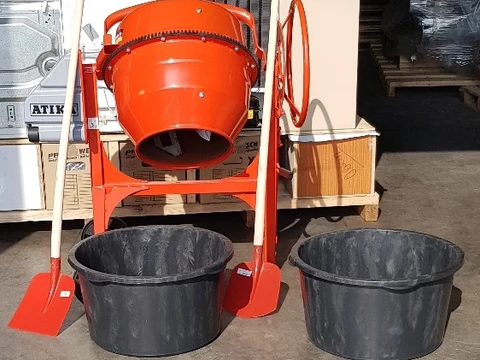 We received this machine from a professional colleague of mine. Practically with shovels and mortar bucket. Many thanks for that!
We received this machine from a professional colleague of mine. Practically with shovels and mortar bucket. Many thanks for that! I have been in my home community since June 13 to collect donations for Togo and later to load a container.

All the concrete has to be mixed by hand - a concrete mixer would be a great relief here.
We didn't need any permits for all the construction work or for drilling the well. What a feeling of freedom for a German. Personal responsibility counts. I found an interesting articleabout the Ahr valley and the problems with reconstruction .
 We also got an electricity connection at some point. We had to cover a distance of 400 m and cross the road.
We also got an electricity connection at some point. We had to cover a distance of 400 m and cross the road.
The masts come from a teak plantation and are up to 10 m long. They are peeled at the bottom and painted with waste oil to prevent termite infestation.
 This is our power connection. The wooden box was supplied, I built the roof myself. The motor protection (disjoncteur)
This is our power connection. The wooden box was supplied, I built the roof myself. The motor protection (disjoncteur)
is limited to 15 A, the cables are made of aluminum. I paid the total costs for the 400 m out of my own pocket - around €1000.
 Shell almost finished. The ladder from Germany has done a good job. The bricklayer with apprentice. They both look slender, but I am always amazed at how strong and persistent they are! The orange buckets are split canisters and the handles are covered with a water hose.
Shell almost finished. The ladder from Germany has done a good job. The bricklayer with apprentice. They both look slender, but I am always amazed at how strong and persistent they are! The orange buckets are split canisters and the handles are covered with a water hose.
 The tiles are laid. With cement slurry in the fresh screed. The terrace is 3×7 m. The living room incl. WC shower and office is 4×7 m. Floor tiles €3.75/m2 Wall tiles €4.50/m2. The fridge and tiles are considered a luxury in Togo. At the bottom of the picture is Nico the guard dog. He has already warned us of snakes and scorpions at night. He reliably announces strangers.
The tiles are laid. With cement slurry in the fresh screed. The terrace is 3×7 m. The living room incl. WC shower and office is 4×7 m. Floor tiles €3.75/m2 Wall tiles €4.50/m2. The fridge and tiles are considered a luxury in Togo. At the bottom of the picture is Nico the guard dog. He has already warned us of snakes and scorpions at night. He reliably announces strangers.
 Here you can see 2 home-made rammers still in the formwork made of concrete blocks. These were used to tamp the floor under the concrete slab before concreting. The stones for the formwork are 20x20x40 in size.
Here you can see 2 home-made rammers still in the formwork made of concrete blocks. These were used to tamp the floor under the concrete slab before concreting. The stones for the formwork are 20x20x40 in size.
 At last there is some news from Togo, it was long overdue. Here you can see the floor slab for the office with drainage pipes for the shower and toilet. In the background is the small container with a second skin for insulation.
At last there is some news from Togo, it was long overdue. Here you can see the floor slab for the office with drainage pipes for the shower and toilet. In the background is the small container with a second skin for insulation.
Previously I measured temperatures up to 50 degrees Celcius.
 The clay bricks are processed. The mortar is also made with the red clay. Note the Togolese scaffolding! The orange tubes in the base plate are conduits for electric cables. The VA tension wires are already inside!
The clay bricks are processed. The mortar is also made with the red clay. Note the Togolese scaffolding! The orange tubes in the base plate are conduits for electric cables. The VA tension wires are already inside!
 Here the wall on the outside.
Here the wall on the outside.
Scaffolding is simple and effective. There is not much material in Togo, but all the more ingenuity. The concrete posts were later plastered and painted with paint
 The foundations for the small office have been laid. But there is still no money for the further construction!
The foundations for the small office have been laid. But there is still no money for the further construction!
 This is my bathroom next to the large container.
This is my bathroom next to the large container.
 This is my bedroom in the small container. I've been sleeping there for 3 months!
This is my bedroom in the small container. I've been sleeping there for 3 months!
 13.05.2022: Finally some news from Togo. Everything is taking a little longer here, but the gates are finally finished and installed. These are important to protect against thieves. A big problem here and a consequence of poverty. Barbed wire is to be installed on the walls. This was recommended to me by several people.
13.05.2022: Finally some news from Togo. Everything is taking a little longer here, but the gates are finally finished and installed. These are important to protect against thieves. A big problem here and a consequence of poverty. Barbed wire is to be installed on the walls. This was recommended to me by several people.
 So far, the only place to retreat or sleep has been the container. This is set to change. A small office with overnight accommodation is to provide a remedy. Donations are still needed for this.
So far, the only place to retreat or sleep has been the container. This is set to change. A small office with overnight accommodation is to provide a remedy. Donations are still needed for this.
 In the picture in the middle you can see the stone makers. Using a special press, stones are pressed from red clay and a little cement to create a great indoor climate. The stones have to be protected from the sun and rain. Thanks to the truck tarpaulins from Giesker and Laakmann, we were able to build a proper shelter! The stones are ready but donations are still needed for the rest of the building project. Thank you in advance for any help!
In the picture in the middle you can see the stone makers. Using a special press, stones are pressed from red clay and a little cement to create a great indoor climate. The stones have to be protected from the sun and rain. Thanks to the truck tarpaulins from Giesker and Laakmann, we were able to build a proper shelter! The stones are ready but donations are still needed for the rest of the building project. Thank you in advance for any help!
 We would like to take this opportunity to thank Paletten Robers, Werkmarkt Schmeing, both from Südlohn, and the Stade company from Dülmen-Buldern for their fantastic donations. We can make very good use of everything here.
We would like to take this opportunity to thank Paletten Robers, Werkmarkt Schmeing, both from Südlohn, and the Stade company from Dülmen-Buldern for their fantastic donations. We can make very good use of everything here.  Here is some more material. The milling machine, the chipper and the generator were unloaded at night from a truck with a small crane.
Here is some more material. The milling machine, the chipper and the generator were unloaded at night from a truck with a small crane.
 As no crane was available, the container was to be unloaded using the African method. The container was tied to a tree with 2 chains and the truck moved forward quickly. Unfortunately, the container got caught halfway and the truck was unable to maneuver because all the weight was resting on the back. Later, the small crane came back and lifted the container at the front and later lowered it gently to the ground.
As no crane was available, the container was to be unloaded using the African method. The container was tied to a tree with 2 chains and the truck moved forward quickly. Unfortunately, the container got caught halfway and the truck was unable to maneuver because all the weight was resting on the back. Later, the small crane came back and lifted the container at the front and later lowered it gently to the ground.
 The container is loaded again in an orderly fashion. But first there was still some work to be done, namely getting the large container into place. The next night, we were able to organize a larger truck from the road construction company. This was able to lift the empty 4 ton container into place. The machine operators are very closely monitored and it is very difficult to work alongside them. After several attempts, we managed to organize a truck with a powerful crane. It arrived in the dark and we had to switch off all the lights. It went relatively quickly and some people had a little extra income and everyone was happy.
The container is loaded again in an orderly fashion. But first there was still some work to be done, namely getting the large container into place. The next night, we were able to organize a larger truck from the road construction company. This was able to lift the empty 4 ton container into place. The machine operators are very closely monitored and it is very difficult to work alongside them. After several attempts, we managed to organize a truck with a powerful crane. It arrived in the dark and we had to switch off all the lights. It went relatively quickly and some people had a little extra income and everyone was happy.
A big problem was solved!
 Sunday 6.2.22 in the evening at 5.30 pm. At last, the container has arrived! There are papers in Togo too. The truck driver on the left and the customs officer on the right. The officials in Togo are quite receptive to a small pay rise and there are no problems. When the container was one third unloaded, it disappeared.
Sunday 6.2.22 in the evening at 5.30 pm. At last, the container has arrived! There are papers in Togo too. The truck driver on the left and the customs officer on the right. The officials in Togo are quite receptive to a small pay rise and there are no problems. When the container was one third unloaded, it disappeared.
 The seals on the container are removed and the unloading can begin. I then had a lot to sort out and we didn't finish until late at night
The seals on the container are removed and the unloading can begin. I then had a lot to sort out and we didn't finish until late at night
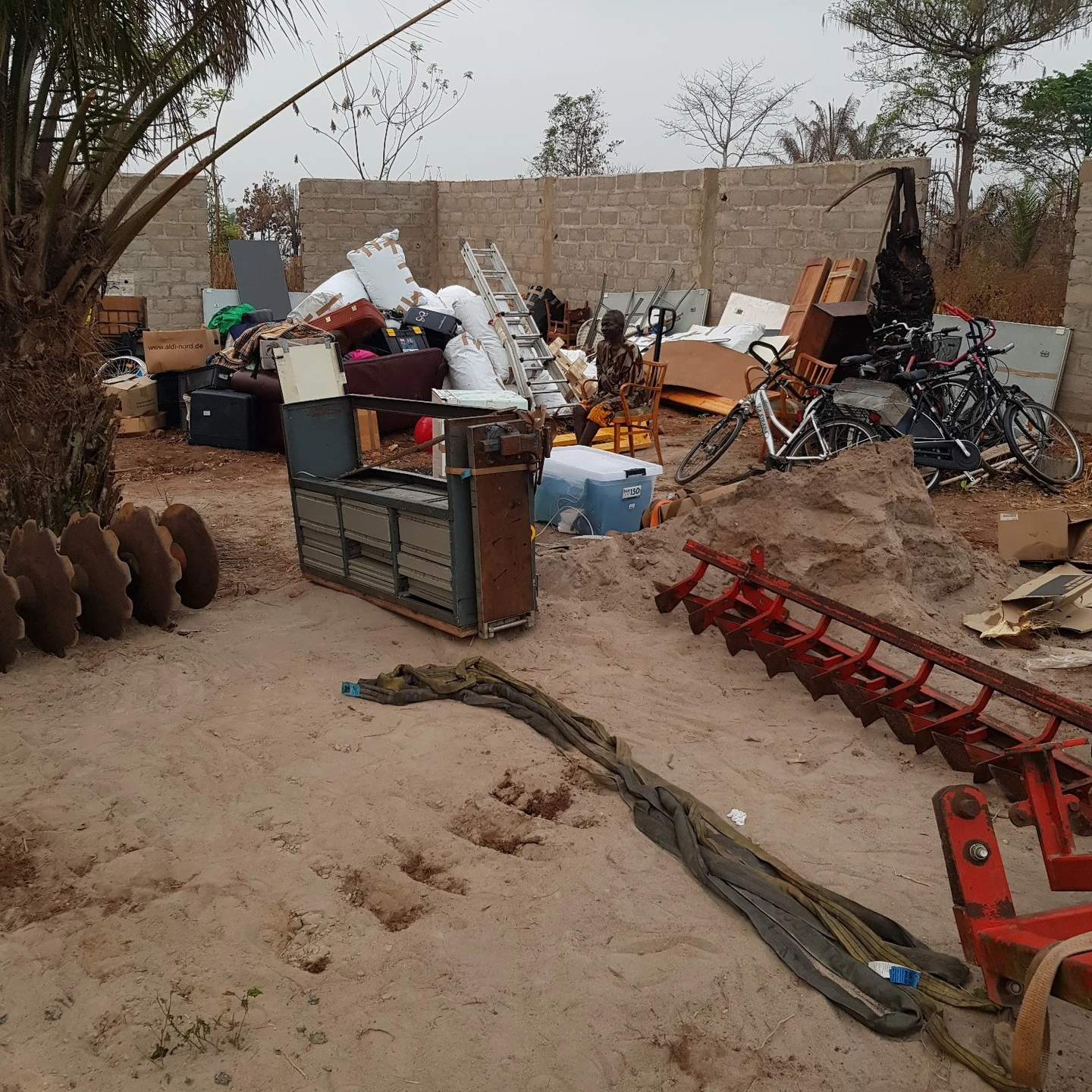 This is what it looked like the next morning.
This is what it looked like the next morning.
That same night another small container was delivered which I received from Father Marian of the Steyler Missinars. Later the material will be distributed between the 2 containers. The large container donated by Bewital will serve as a secure storage room and the small container will be used as a workshop.
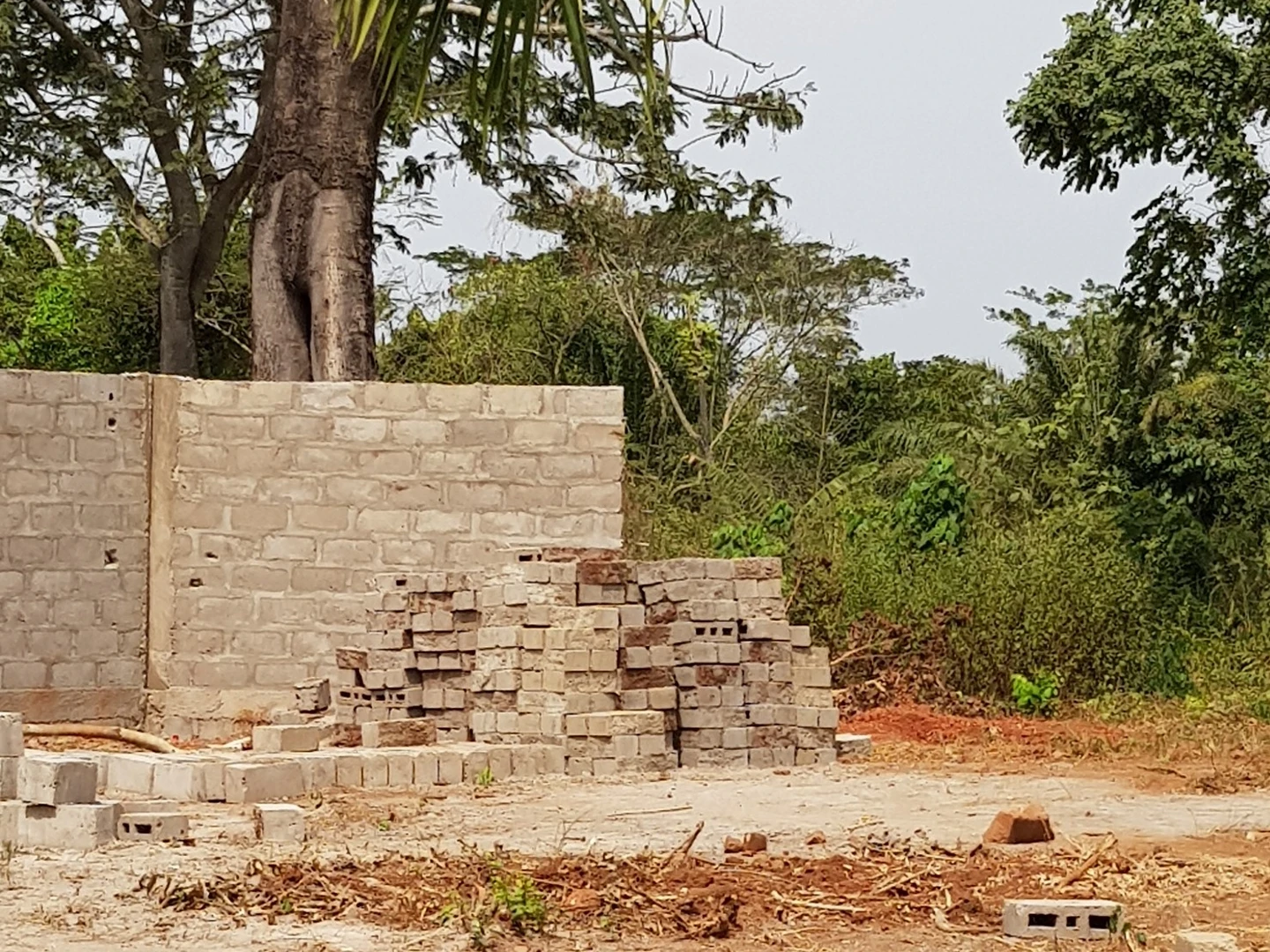 The wall is ready and when the container is delivered the rest will be bricked including the foundations for the sliding gate. Unfortunately, our donation account will be empty again after the container is delivered and we still need some money to make the gates. urgent donations
The wall is ready and when the container is delivered the rest will be bricked including the foundations for the sliding gate. Unfortunately, our donation account will be empty again after the container is delivered and we still need some money to make the gates. urgent donations
 The wall is stabilized by a concrete post every 3.5 metres. The built-in iron mesh extends into the foundations, making the whole thing quite stable even though the stones are only 10 cm thick. On the left in the picture is the black water tank with hose to the well. The underwater pump is powered by a generator
The wall is stabilized by a concrete post every 3.5 metres. The built-in iron mesh extends into the foundations, making the whole thing quite stable even though the stones are only 10 cm thick. On the left in the picture is the black water tank with hose to the well. The underwater pump is powered by a generator
 The iron mesh for the foundations and the concrete posts is bent and woven on site. There are specialists for this.
The iron mesh for the foundations and the concrete posts is bent and woven on site. There are specialists for this.
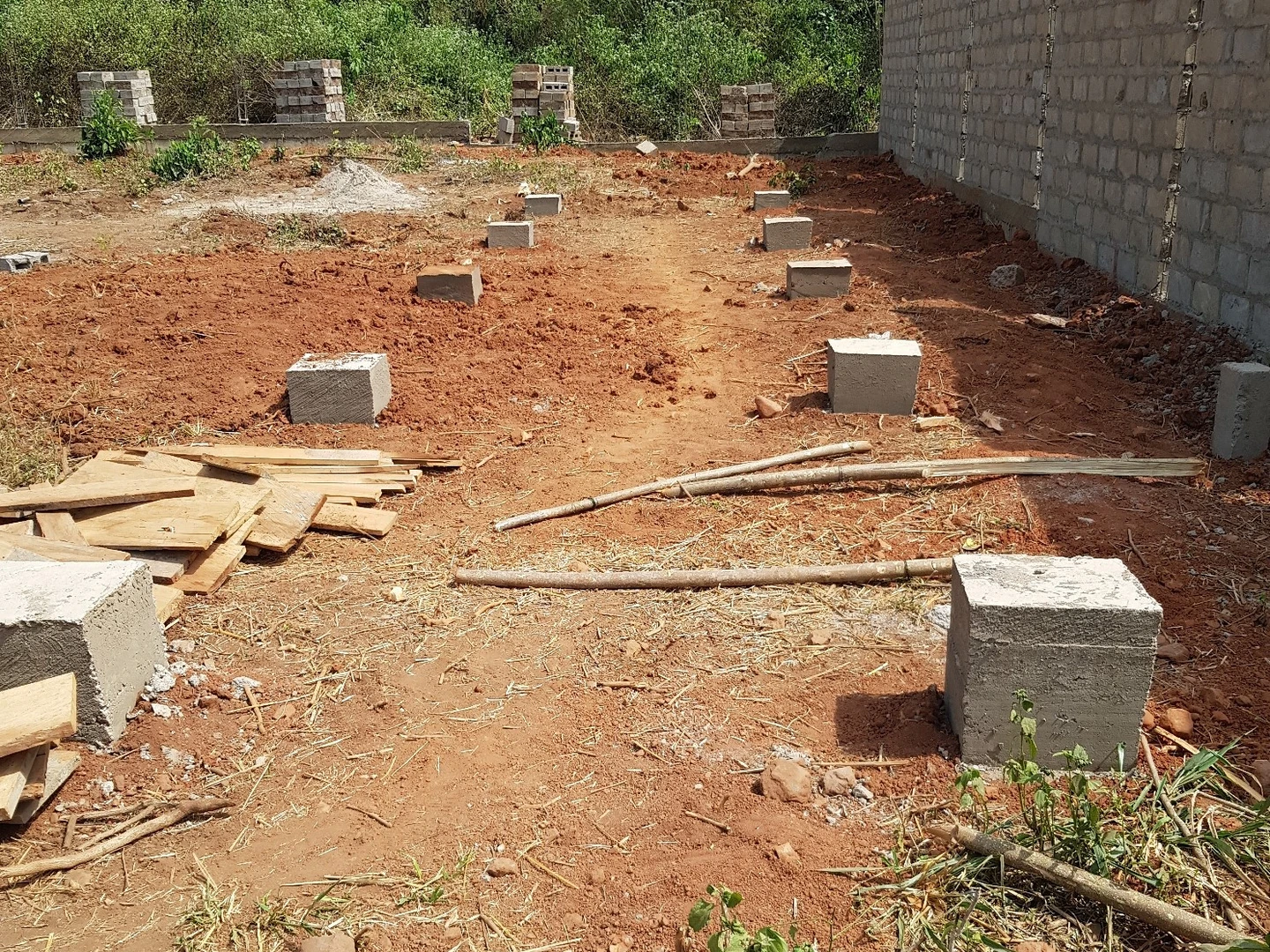 These are the foundations for the container. The storage must be raised so that no termites can get in. I measured the height of the foundations myself with a hose scale. The container should arrive in the course of this week (2nd week).
These are the foundations for the container. The storage must be raised so that no termites can get in. I measured the height of the foundations myself with a hose scale. The container should arrive in the course of this week (2nd week).
 The construction of the wall is progressing well. At the moment they are even working on Sundays
The construction of the wall is progressing well. At the moment they are even working on Sundays
 This is scaffolding Togolese, but it works.
This is scaffolding Togolese, but it works.
 The bricks needed for the wall are made by hand. Production is in full swing!
The bricks needed for the wall are made by hand. Production is in full swing!
 This is one of the molds used to make the stones.
This is one of the molds used to make the stones.
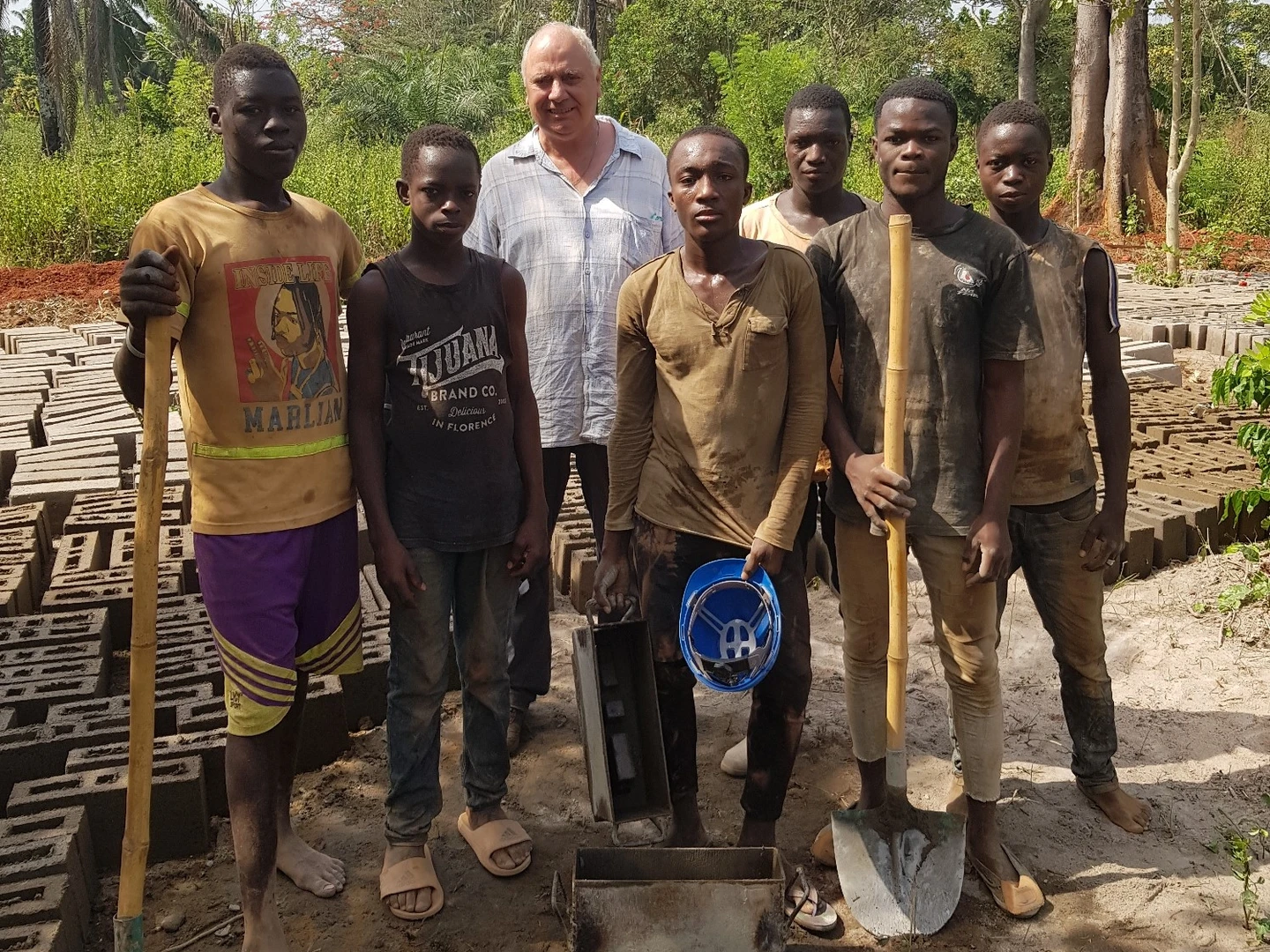 Sand and cement are mixed several times and with great skill. Later, a second person adds water until the whole thing is moist. Then it's off to the molds.
Sand and cement are mixed several times and with great skill. Later, a second person adds water until the whole thing is moist. Then it's off to the molds.
 Here is a detail from the formwork for the concrete posts. A hole is made in the wall for the clamps to pass through. Some of the clamps are forged from structural steel.
Here is a detail from the formwork for the concrete posts. A hole is made in the wall for the clamps to pass through. Some of the clamps are forged from structural steel.
 A snapshot in Kpalmié.
A snapshot in Kpalmié.
Transporting boards in Togolese. Just think how skillful these people are!
 Sand and cement are mixed several times and with great skill. Later, a second person adds water until the whole thing is moist. Then it's off to the molds.
Sand and cement are mixed several times and with great skill. Later, a second person adds water until the whole thing is moist. Then it's off to the molds.
 The foundations are excavated.
The foundations are excavated.
Everything is done by hand. I am now very impressed by the efficiency of these young men.
Everything is done by hand. I am now very impressed by the efficiency of these young men.
 The cement is also stored in the warehouse. 200 bags, all carried in by hand, 50 kg per bag.
The cement is also stored in the warehouse. 200 bags, all carried in by hand, 50 kg per bag.
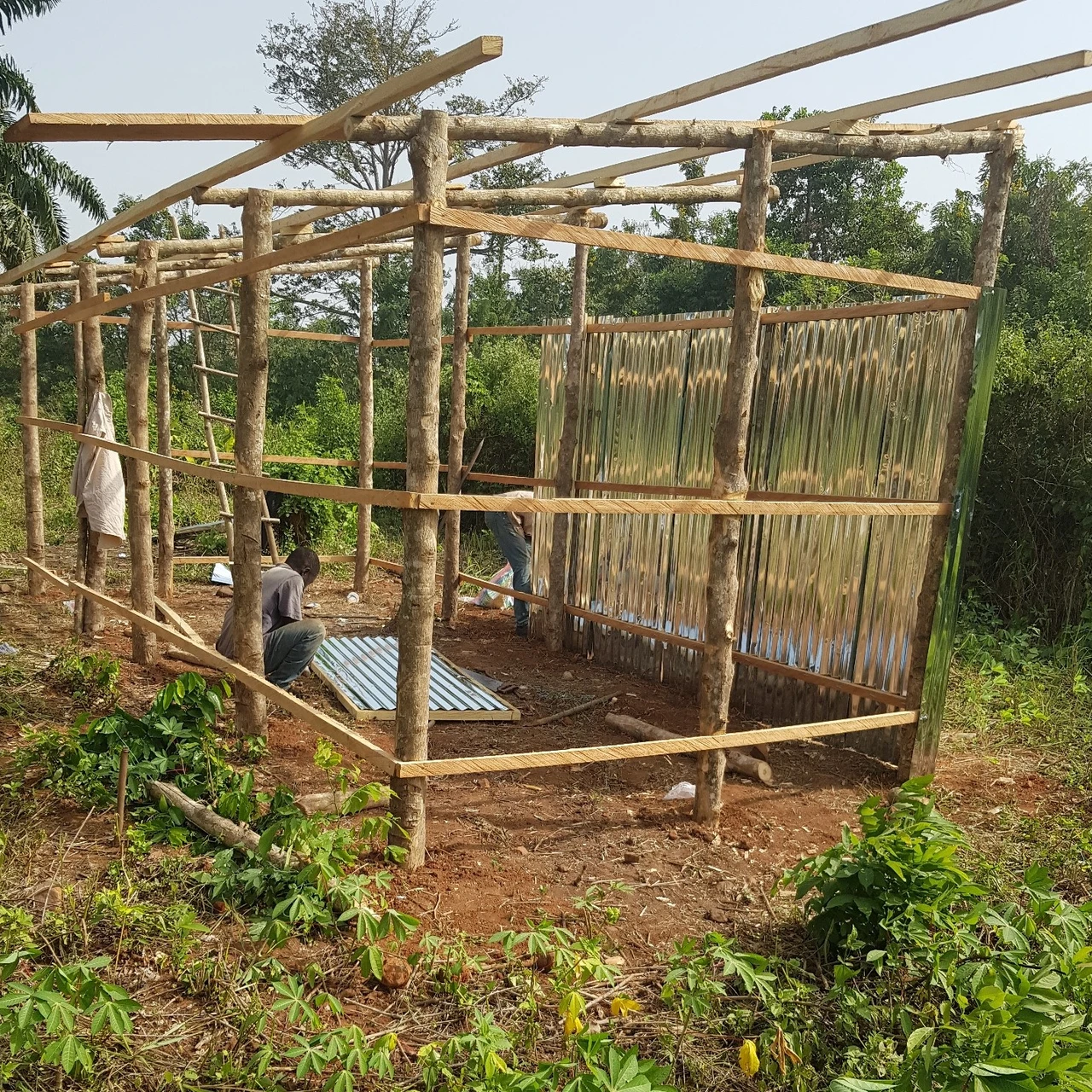 Thanks to the donations received, we were also able to start building a wall around the planned machine station. First of all, a warehouse will be built to protect against theft.
Thanks to the donations received, we were also able to start building a wall around the planned machine station. First of all, a warehouse will be built to protect against theft.
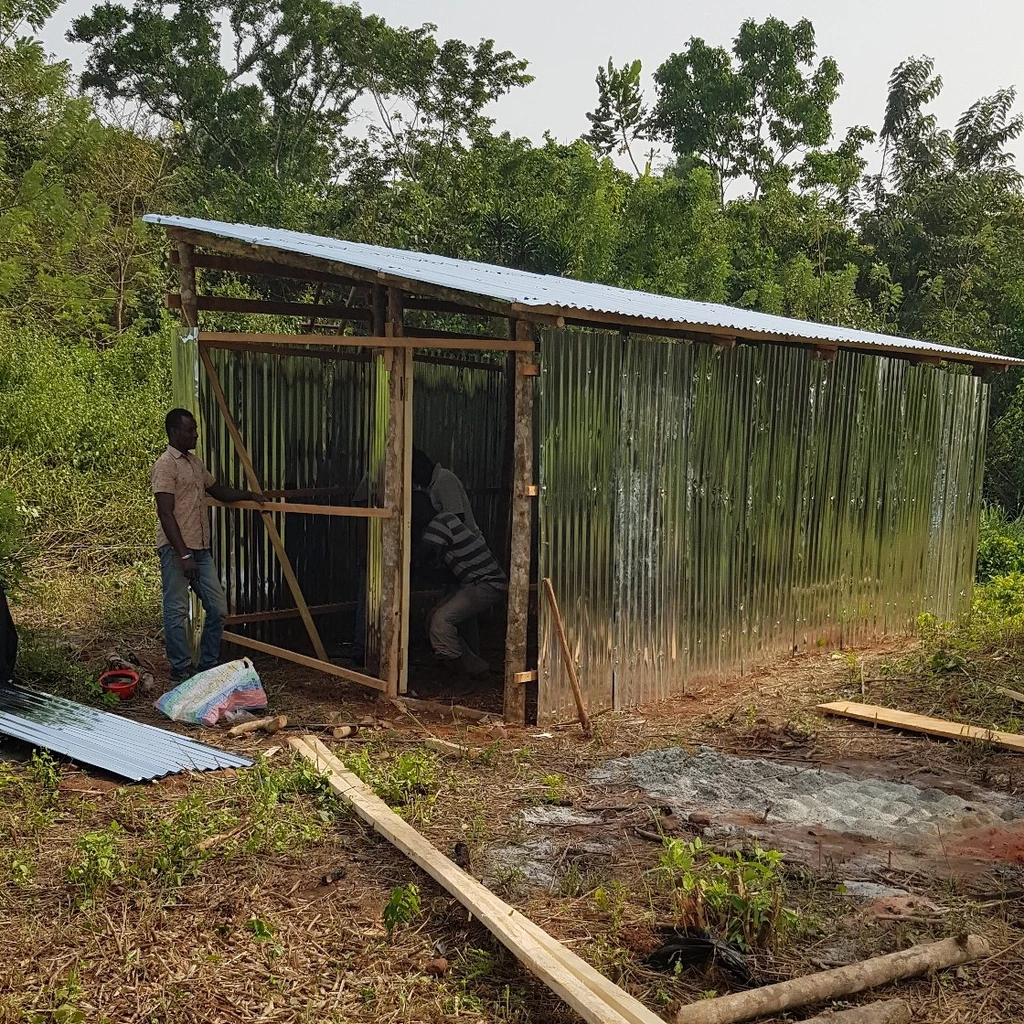 With a great deal of craftsmanship, the first building is constructed in no time at all. This will later remain standing for various purposes.
With a great deal of craftsmanship, the first building is constructed in no time at all. This will later remain standing for various purposes.
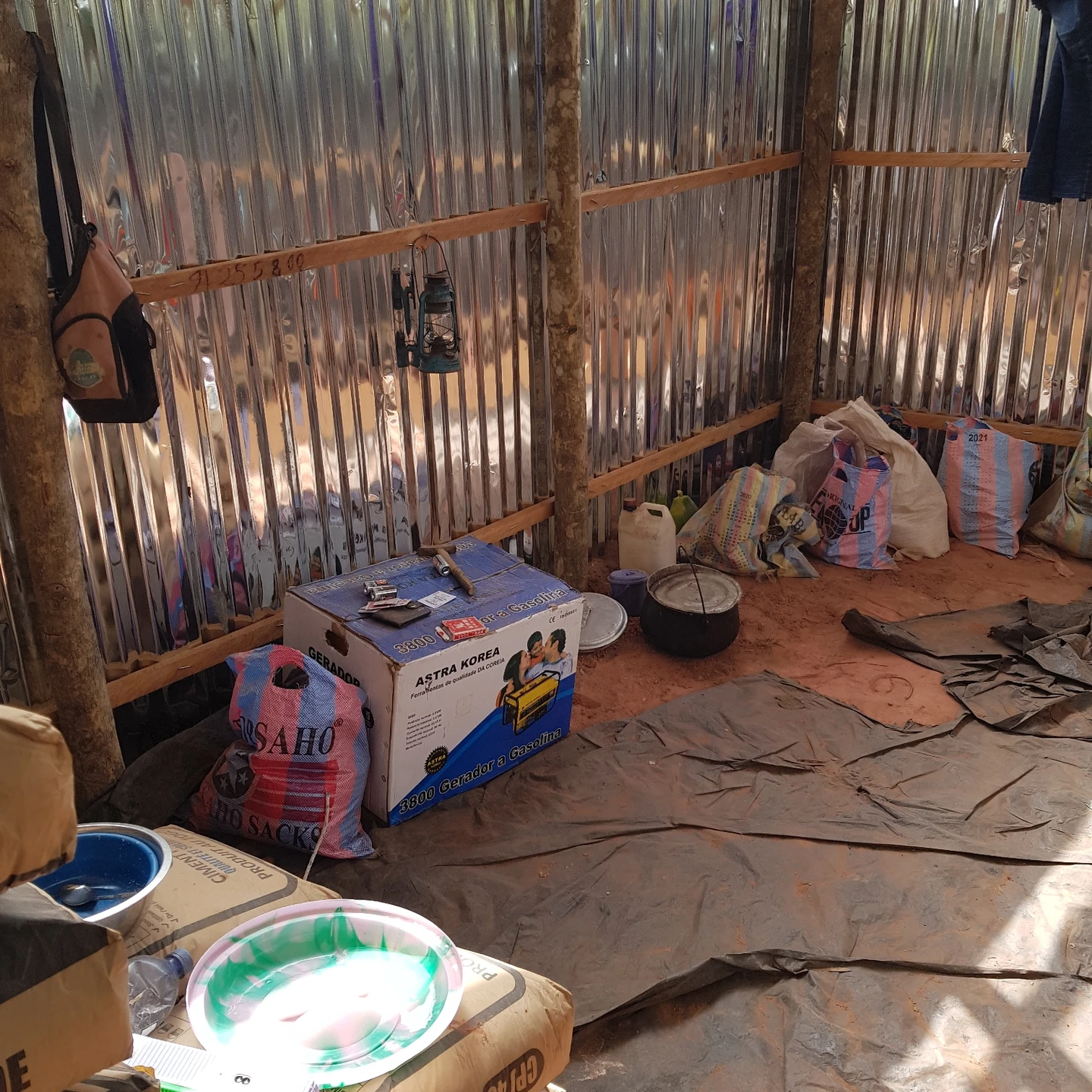 The boys also sleep in the magazine.
The boys also sleep in the magazine.
So nothing is stolen. Water from the tank is sufficient for showering and cooking is also done on site.
Dec. 21
 Thanks to some large donations, including from Ludger Gausling from Heek and Peter Emming Agrarkontor, it was possible to continue the project. We were able to drill a borehole for the water supply. Beforehand, the site was searched by a dowser to find a suitable location.
Thanks to some large donations, including from Ludger Gausling from Heek and Peter Emming Agrarkontor, it was possible to continue the project. We were able to drill a borehole for the water supply. Beforehand, the site was searched by a dowser to find a suitable location.
 Dry drilling is used here. The drill dust is pressed upwards with air.
Dry drilling is used here. The drill dust is pressed upwards with air.
I would like to take this opportunity to thank all donors, including those who do not wish to be named.
 We found the first water at 70m and drilled further to 90m. The water is of very good quality and can be drunk. Good water is highly valued, especially in Africa.
We found the first water at 70m and drilled further to 90m. The water is of very good quality and can be drunk. Good water is highly valued, especially in Africa.
At the moment we are in the process of preparing the site of the machine station to receive the container, which is due to arrive at the end of December. We have to build a wall around the site and drill a well for the water supply. We urgently need financial help for this!
 The container is loaded with great skill. The disc harrow has been dismantled to make optimum use of the space.
The container is loaded with great skill. The disc harrow has been dismantled to make optimum use of the space.
There were very good packing masters at work!
 We would like to take this opportunity to thank Hubert Laakmann and his staff for their great support.
We would like to take this opportunity to thank Hubert Laakmann and his staff for their great support.
Many, many thanks !!!
A video of my move with interview
I have been back in Togo since November 3, 2021. The journey went without a hitch.
On 29.10. the material for the container was transported from Südlohn to Nottuln to the Giesker&Laakman forwarding company, where the container has been parked since 27.10.21.
I am now here in Togo sorting out all the formalities for the shipment.
I would like to take this opportunity to thank Paletten Robers and Werkmarkt Schmeing for their extensive donations in kind.
In addition, employees of Haus Hall have collected used work shoes that are urgently needed. Thank you very much!!!
I would also like to thank the freight forwarder Giesker&Laakman for their great support.
And special thanks to my friend Charly!!!
9.9.21 ,I have just received confirmation that a 40 foot container will be donated.
This gives me enormous motivation. Thank you thank you thank you !!!
 The beans on the grounds of the machine station are sown. 21.8.21
The beans on the grounds of the machine station are sown. 21.8.21
 And the beans are already showing .
And the beans are already showing .
24.8.21, that's how fast it goes here!
 The beans are coming along well. 4.9.21
The beans are coming along well. 4.9.21
 04.08.21 The site continues to be cleared.
04.08.21 The site continues to be cleared.
 The Secrétaire Générale keeps me reliably informed!
The Secrétaire Générale keeps me reliably informed!
 It's finally starting. The area for the project is cleared. This is the work crew.
It's finally starting. The area for the project is cleared. This is the work crew.
 At the moment it can only be done by hand. We work until midday, then it's too hot.
At the moment it can only be done by hand. We work until midday, then it's too hot.
 Everyone needs a break. White beans are still to be sown on the plot and will be ripe in 2 months. And then I'll be back.
Everyone needs a break. White beans are still to be sown on the plot and will be ripe in 2 months. And then I'll be back.
This is the logo of the ONG ARMA
ONG stands for Organization non Government (non-governmental organization)
ARMA = Association pour un Rendement Meilleur en Agriculture
Association for the improvement of yields in agriculture
The documents are ready and the application will be sent to the ministry soon.
This was only possible because I found some good and helpful friends.
The ONG consists of:
1: President, that's me
2: Secrétaire Générale (Secretary General)
3: Trésoriere (Treasurer)
4: 2 Conseillers (Advisors)
The goals and tasks of the ONG are:
1: Mechanization of agriculture
2: Improving the working conditions of farmers
3: Training farmers in the maintenance and repair of machinery
4: Advising farmers on arable farming and increasing yields

 This is what the site looks like at the moment and comprises 2 lots. In Togo, land is traded in lots. 1 lot is 600 square meters. The undergrowth will soon be removed by hand. Larger trees will remain as long as they do not interfere. Shade donors are always welcome!
This is what the site looks like at the moment and comprises 2 lots. In Togo, land is traded in lots. 1 lot is 600 square meters. The undergrowth will soon be removed by hand. Larger trees will remain as long as they do not interfere. Shade donors are always welcome!
 This is an overview map. Unfortunately the photo is blurred. At the top right are the 2 plots for the project directly on the main road. The location on the main road contributes to safety. I was strongly advised against a location away from houses. Togo is not far from the equator and the nights are the same length almost all year round. It is dark at 19:00 and light again at 5:00. It is 11 km to Kpalimé.
This is an overview map. Unfortunately the photo is blurred. At the top right are the 2 plots for the project directly on the main road. The location on the main road contributes to safety. I was strongly advised against a location away from houses. Togo is not far from the equator and the nights are the same length almost all year round. It is dark at 19:00 and light again at 5:00. It is 11 km to Kpalimé.
 In a poor country like Togo, it is particularly important to protect your property. First of all, a 2.5m wall is erected around the site with a large access gate. Possibly with barbed wire on top. There is an electricity connection 300m away.
In a poor country like Togo, it is particularly important to protect your property. First of all, a 2.5m wall is erected around the site with a large access gate. Possibly with barbed wire on top. There is an electricity connection 300m away.